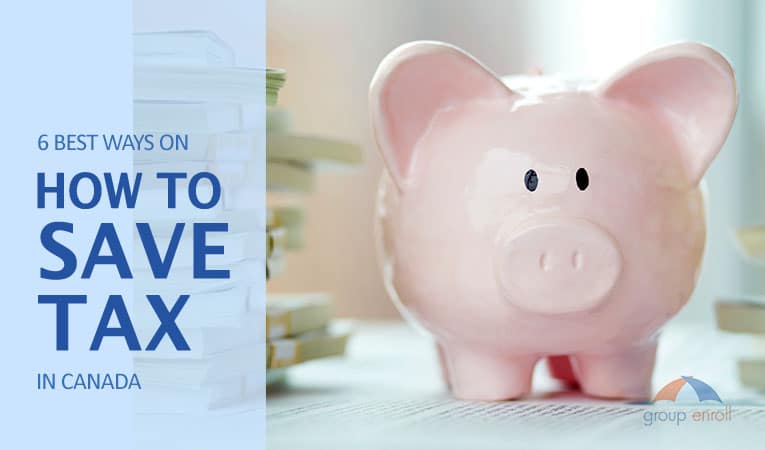A tax-free savings account, or TFSA, is a type of Canadian savings account that holds different kinds of investments and allows tax-free withdrawals. Canadians over the age of 18 with a valid social insurance number (SIN) are welcome to open a TFSA for any reason.
Table of Contents
What is a TFSA?
Canada initiated the first tax-free savings accounts in 2009. During this time, the contribution limit was $5,000 annually. The TFSA contribution limit increased to $5,500 in 2013 and did not increase again until 2015 when the limit became $10,000. Currently, the contribution limit sits at $6,000.
The primary benefit of a TFSA is that there is no tax on income within the account. Essentially, this gives Canadians the opportunity to save up to $6,000 without paying income tax on the funds.
Account holders need to remember that TFSA administration fees or contributions are not tax-deductible.
Types of Tax-Free Savings Accounts
TFSAs are flexible accounts that allow for various types of savings or income. Several different institutions can issue tax-free savings accounts, including banks, credit unions, and insurance companies.
TFSAs come in three primary forms:
- Annuity contract: Usually issued by an insurance company, an annuity contract is a legal document binding up to four parties. Essentially, this contract holds the insurance company liable for making regular payments to the annuitant once they retire or request the payments, making it a risk-free retirement fund.
- Deposit: A TFSA deposit account works the same as a standard savings account; holders deposit money into the account where it accrues interest over time. One of the benefits of this type of tax-free savings account is that holders can quickly withdraw money, making it useful for emergency funds and flexible spending.
- Arrangement in trust: A trust arrangement is an agreement in which a third party, such as a bank, holds assets for a beneficiary. Many holders prefer to use trusts over a will as beneficiaries have quicker access to the assets on hold. Additionally, trusts have the potential for reduced estate taxes and court fees.
Contacting a TFSA financial institution can help you determine which type of tax-free savings account is right for you.
What is the Difference Between TFSAs and RRSPs?
An RRSP is a registered retirement savings plan. As the name implies, its primary use is for retirement savings. On the other hand, a tax-free savings account allows for multiple types of savings ranging from investments to securities.
Aside from the accounts’ uses, TFSAs and RRSPs have contrasting tax requirements. Registered retirement savings plan deposits are tax-deductible. TFSA deposits, however, are not deducted from the account holder’s taxable income.
Similarly, TFSA withdrawals are not taxable, whereas RRSP withdrawals are subject to income tax.
TFSA Terms to Know
What is a TFSA? Understanding how a tax-free savings account works requires a basic knowledge of various TFSA-related terms.
Advantage
An advantage refers to any conditional debt or benefit that relies on a TFSA. This includes benefits that increase the fair market value of a TFSA property.
Capital gain or income benefits derivable to a prohibited TFSA investment or over-contribution to the account also fall into the category of an advantage.
Arm’s Length
An arm’s length relationship refers to the transaction attitude between two parties. In an arm’s length relationship, parties engage in standard commercial dealings or agreements while acting in their own interests.
Non-arm’s Length
A non-arm’s length relationship refers to the transaction between two parties related to each other. A non-arm’s length relationship also applies to business partners or any two parties who share similar interests.
Common-law Partner
A common-law partner is a person that lives and maintains a deep or intimate relationship with you. Your common-law partner is not your legal spouse; however, you must be in a relationship with this person for at least 12 consecutive months.
Common-law partners are often co-parents or legal guardians who share custody of your child or children.
Deliberate Over-Contribution
The current contribution limit for a TFSA account in Canada is $6,000. Over-contribution refers to an account contribution that exceeds this limit.
Deliberate over-contribution means that the account holder was aware of the potential tax or penalty for exceeding the contribution limit.
Qualifying Arrangement
A qualifying arrangement is an arrangement between an issuer and a holder. Qualifying arrangements can include trusts or annuity contracts.
Qualifying Transfer
A qualifying transfer refers to the transfer of funds between an account holder’s tax-free savings accounts.
Transfers between the holder’s TFSA and that of their current spouse, former spouse, or common-law partner can also count as a qualifying transfer. However, these transfers must be in accordance with a written agreement or degree that relates to a division of property following a separation.
Successor Holder
A successor holder is a person whom a TFSA holder grants access to following their death. The beneficiary can be a spouse or common-law partner of the account holder.
In the event of the primary account holder’s death, the successor holder takes on the account and earns the right to manage its assets.
Who Can Open a Tax-Free Savings Account?
Any Canadian resident over 18 with a social insurance number is eligible to open and contribute to a tax-free savings account. A non-Canadian resident can also open a TFSA so long as they have a valid SIN.
Although non-residents are eligible to open a tax-free savings account, they are responsible for a 1% tax every month for their TFSA contributions. The only way for account holders to avoid the 2% tax is to become legal Canadian residents.
Non-Residents
The Canada Revenue Agency may determine that you are a non-resident if:
- You customarily live in another country
- You live in another country throughout the tax year
- You have no residential ties to Canada. (Residential ties include a home, spouse or common-law partner, personal property, or social relations in Canada.)
Those who do not live in Canada but have sufficient ties may qualify to open a tax-free savings account. Contact the Canada Revenue Agency to determine your residency status and whether or not you can open a TFSA.
How Do You Open a TFSA?
Canadians can open a tax-free savings account at any time. The first step is to find and contact an issuing financial institution.
Multiple types of financial institutions can issue TFSAs, including:
- Banks
- Credit Unions
- Insurance Companies
After contacting an issuing organization, you must provide your social insurance number and birth date. The financial institution uses this information to register your qualifying arrangement and may request additional paperwork such as IDs or licenses.
If you are an independent investor, a self-directed tax-free savings account lets you manage your own portfolio. A self-directed TFSA allows account holders to buy and sell investments on their own terms and according to their preferences.
TFSA Contributions
A TFSA contribution refers to the amount of money you deposit into your tax-free savings account. Unlike other financial accounts, the TFSA has a cap on how much money you can deposit. This limit is called the contribution room.
All contributions to the account during the year count against your allotted contribution room. This includes deposits that replace withdrawal amounts. Should you deposit more money into your TFSA than your remaining contribution room allows, you will face a penalty or tax.
The tax for over-contribution is 1% of the greatest over-contribution amount for the month. As the account holder, you have sole control over TFSA contributions, withdrawals, and investment decisions.
You can accumulate contribution room before you open a TFSA account so long as you are over 18 and have a valid SIN. You accrue contribution room for every year that you were over 18 since 2009.
TFSA Contribution Room
The TFSA contribution room is the maximum funds that you can deposit into your account during the year.
For Canadian residents who were 18 years old or older in 2009, their contribution room continues to grow every year. This is also true for those who do not open a TFSA or file income tax.
For residents who turned 18 after 2009, the TFSA contribution room begins the year they turn 18 and continues to grow every year after that.
As of 2021, the TFSA contribution limit remains at $6,000. The limit rounds to the nearest $500 when needed for inflation purposes.
Although account holders cannot exceed their contribution room without penalty, any unused contribution room rolls over to the next year. For example, if you contribute only $3,000 to your TFSA during 2020, you have $3,000 of unused contribution room. The $3,000 rolls over to 2021, which means you can contribute the allotted $6,000 plus the unused $3,000 from the previous year.
TFSA account holders can find more information about their contribution room by visiting the Canada Revenue Agency (CRA) website or contacting their issuing institution.
TFSA Withdrawals
A withdrawal refers to the money you take out of your tax-free savings account. Generally, there are no limits on how much you can withdraw; however, this depends on the type of investment in your TFSA. In addition, qualified transfers from one TFSA to another do not count as withdrawals.
Replacing your withdrawal amounts within the same year will count against your contribution room. For example, if you contribute $5,000 during the year and withdraw $2,000, you cannot replace the full $2,000 within the same year as this will count as over-contribution. Re-contributions that exceed the contribution limit are subject to the 1% tax on the highest excess deposit amount for the month.
How Can You Authorize a Representative?
By authorizing a representative, you give another party permission to access your tax information and report it to the Canada Revenue Agency. An authorized representative can be a spouse, common-law partner, accountant, or tax preparer.
TFSA account holders can authorize a representative through the CRA.
The representative authorization ends when the account holder or the authorized representative cancels the agreement, the authorization reaches an expiration date, or the account holder dies.
Permitted TFSA Investments
TFSA-permitted investments are generally the same as those of a registered retirement savings plan. These investments include cash, mutual funds, bonds, securities, investment certificates, and certain small business shares.
Any losses that affect your original investments are not considered a withdrawal and don’t count against your contribution room.
Account holders can also contribute foreign funds to their tax-free savings account. When contributing foreign funds, it is essential to remember that your TFSA issuer will convert any foreign currency into Canadian dollars. The amount after the currency conversion must not exceed your contribution room; otherwise, you are subject to tax or penalty.
Dividend income paid to your TFSA from a foreign country is subject to foreign withholding tax.
Prohibited TFSA Investments
A prohibited investment is closely associated with the tax-free savings account holder. For example, prohibited TFSA investments can include:
- Holder debts
- Interest in a corporation
- Interest in a trust with a non-arm’s length relationship
Generally, mortgage loans through the Canada Mortgage and Housing Corporation do not count as prohibited investments.
How to Report TFSA Information to the CRA
Your financial institution issuing your tax-free savings account is primarily responsible for reporting your account information to the CRA. TFSA issuers must send a record for every account holder to the Canada Revenue Agency by the end of February each year.
Account holders must review their TFSA statements to confirm that their information is correct. If your issuer’s report contains inaccurate information, you must fill out and send the CRA a revised record as soon as possible.
6 Best Ways on How to Save Tax in Canada
Read this article to learn how to save on taxes in Canada.
Group Insurance Policies
Insurance companies are common issuers for tax-free savings accounts. However, many organizations in Canada struggle to find the right insurance policy and carrier for their employees.
From costs to coverage, managers and business owners have several factors to consider when searching for group insurance. With hundreds of options out there, it can seem like an endless challenge trying to narrow down the best and most affordable group insurance policies.
That’s where Group Enroll comes in. Group Enroll is Canada’s premier insurance broker. We help people find the best rates and policies for various types of group insurance, including:
- Dental Insurance
- Extended Health Care
- Life Insurance
- Disability Insurance
- Retirement Savings Plans
- Health Care Spending Accounts
To get started, all you have to do is fill out the quote form to help us gather more information about your specific needs. Then, we source multiple proposals from the top insurance carriers in Canada. Finally, we narrow down the best options for you, so all you have to do is pick from the most competitive offers.
What is a TFSA, and where can you find more information about group insurance? You can email us at [email protected] or find us at 10 Great Gulf Drive, Unit 5, Vaughan, ON, L4K 0K7.








